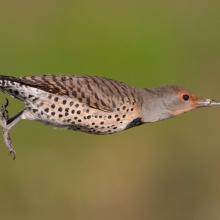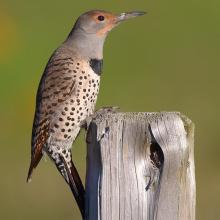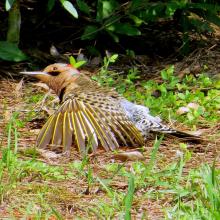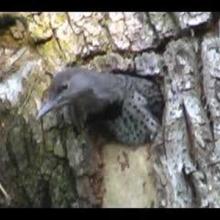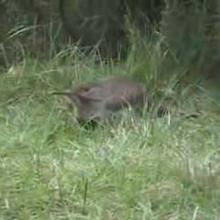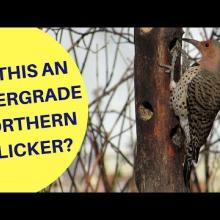

Join BirdNote tomorrow, November 30th!
Illustrator David Sibley and actor H. Jon Benjamin will face off in the bird illustration battle of the century during BirdNote's Year-end Celebration and Auction!
When a Northern Flicker takes flight, a bold patch of white feathers flashes on its rump, in contrast to its brown body. This white rump likely evolved as an anti-predator adaptation. A hawk flying in pursuit of a flicker may focus on the white spot rather than the darker image of the whole bird. This gives the flicker an advantage as it dodges into the trees. Then the white target disappears beneath the bird’s folded wings. An instant of confusion for the hawk allows just enough time for the flicker to sidle around to the other side of the tree.
BirdNote®
Chasing the Flicker’s White Rump
Written by Bob Sundstrom
This is BirdNote.
[Northern Flicker call, http://macaulaylibrary.org/audio/84808, 0.06-.10]
Our most commonly seen woodpeckers are Northern Flickers — beautiful tan birds with brightly colored underwings, spotted belly, barred back, and bold black breastplate. [Northern Flicker drum, http://macaulaylibrary.org/audio/94347, 0.25-26]
When a flicker takes flight, a bold patch of white feathers flashes on its rump, in sharp contrast to its brown body. Against the dark forest edge, only this white flash shows up.
This white rump very likely evolved, at least in part, as an anti-predator adaptation. A hawk flying in pursuit of a flicker may fix on the conspicuous white spot rather than the darker image of the whole bird. This gives the flicker a split-second advantage as it suddenly dodges into the trees. Then as it clamps itself to a tree trunk, the white target disappears beneath its folded wings. An instant of confusion for the hawk allows just enough time for the flicker to sidle around to the other side of the tree. [Northern Flicker call, http://macaulaylibrary.org/audio/134147, 0.27-.29]
Such sharply contrasting patterns — the snap from conspicuous to cryptic visual signals — are widespread in nature. Think of the dark-then-light flash of an alarmed school of fish. Or the erratic bouncing of the cottontail rabbit’s white tail, as it darts into the brush ahead of a chasing coyote.
For BirdNote, I’m Michael Stein.
###
Bird sounds provided by The Macaulay Library of Natural Sounds at the Cornell Lab of Ornithology, Ithaca, New York. Northern Flicker call [84808] and drum [94347] recorded by W L Hershberger; call [134147] recorded by Gerrit Vyn.
BirdNote’s theme music was composed and played by Nancy Rumbel and John Kessler.
Producer: John Kessler
Executive Producer: Dominic Black
© 2016 Tune In to Nature.org January 2018/2021 Narrator: Michael Stein
ID# NOFL-04-2016-01-18NOFL-04





